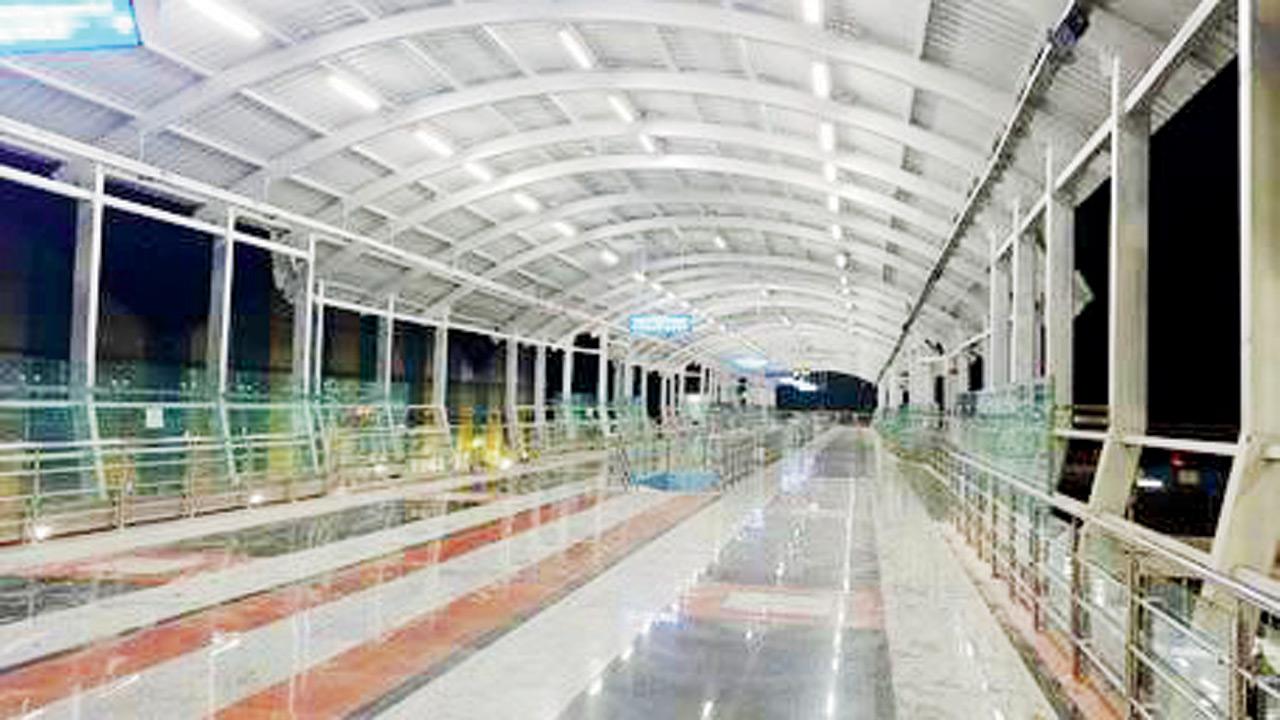Commuters are fuming after the Railways spent crores on retiling station foot overbridges (FOBs) and concourses with glossy flooring that turns dangerously slippery in the rains. From Bandra to Grant Road, Dadar to Mumbai Central, the new tiles are less a facelift and more a fall trap, raising safety concerns yet again.
“I was hurrying to catch my morning train at Mulund, taking the newly built central foot overbridge on the Kalyan side. From a distance it looked impressive — shiny, wide, airy and modern. But the moment I stepped onto it, I realised it was dangerously slippery. Despite wearing my monsoon shoes, they slid on the tiles underfoot. This was just after a slight drizzle, and the floor had turned into a trap.
Grant Road: Newly laid glossy tiles on FOB raise safety concerns for commuters
As I walked carefully, I suddenly lost balance—my foot skidded forward, but I managed to steady myself before falling. Since that close call, I move nervously across the bridge, almost tiptoeing to avoid a fall. The new bridge has become a daily hazard. The old bridges may be overcrowded, but their rough flooring at least offers grip. That’s why many of us still prefer them, even when the new FOB is closer and more spacious. The same tiles have been laid at Thane, Kurla and Ghatkopar, and all have the same problem. Earlier, such tiles used to be roughened up right after installation, but no such precaution seems to have been taken here,” said Mulund student commuter Gandharva Purohit.
Safety vs shine
Has the Railways’ fad of “improving façades” gone horribly wrong? Commuters rushing through suburban stations and foot overbridges (FOBs) this monsoon say so. Gleaming granite and vitrified tiles — marketed as modern, durable and attractive — have instead turned into skating rinks.
Dadar: Gleaming new flooring at Dadar station staircase becomes a slip hazard in wet weather
Despite repeated complaints of slips and near falls, Railways continue to use granite flooring in station upgrades, citing durability, aesthetics and low maintenance. The issue is most acute on newly built FOBs and stations redeveloped under the Amrit Bharat scheme. “Running for a train becomes risky, especially on FOBs and staircases. One wrong step and you can slip,” said Sohum Mhatre, a daily traveller from Kalyan.
Mulund: Shiny new flooring on the foot overbridge at Mulund station which becomes a slip hazard during monsoon
Most of these slippery tiles were installed under Prime Minister Narendra Modi’s Amrit Bharat Station Upgrade plan, which ironically was meant to make stations safer and commuter-friendly. The problem is persistent all over India across stations and foot overbridges due to the Central government’s focus on aesthetics rather than utility and quality.
Why granite and vitrified?
Railway engineers defend the choice. Granite, they say, is among the hardest natural stones, stain- and fire-resistant, requiring little upkeep. Vitrified tiles are lighter, cheaper, faster to lay and easier to source in bulk, while still offering a glossy finish.
FOB between Bandra and Khar: Shiny new flooring on the foot overbridge between Bandra and Khar turns slippery in the rains
“In high-traffic zones, this flooring lasts much longer than other materials and is far more durable. It also gives stations a premium, modern look in line with Amrit Bharat and MRVC upgrades. Granite is used only in premium stations, lounges or heritage-style restorations since it is costlier and heavier,” a senior railway official said.
Officials also claimed that precautions had been taken: anti-slip treatments, rough finishes and Kota stone mixes on walkways. “The idea is to balance heritage and modern looks with commuter safety,” a spokesperson said.
Voices of concern
Ritesh Karkera, advocate
“There’s a thin line between cleanliness and fancy. Granite flooring on railway platforms is not just a waste of public money, but an open invitation to mishaps. Safety must come before showpiece projects”
Shreyas Save, Commuter
“Many stations have vitrified and granite flooring that becomes slippery during rains. Please replace these with anti-skid tiles or apply textured finishes. Check Charni Road and Mumbai Central FOBs”
Shailesh Goyal a former member of the National Railway Users Consultative Committee,
“Vitrified and granite may look shiny and modern, but for lakhs of commuters racing against time, safety underfoot is what matters. On staircases, these tiles are particularly dangerous because of their sharp edges”
Khurshed Lawyer, commuter
“Granite flooring is glamorous and easy to clean, no doubt. But it is risky in every season, especially the monsoon. It must be roughed up or replaced”
Other commuters echoed similar concerns
Hemant Solanki
“The glossy tiles at Ghatkopar under the FOB are a monsoon risk. They must be replaced”
Hemant Bharati
“All new staircases are slippery. Accidents are bound to happen”
Svetlana Pinto
“Same problem at Grant Road. You need to walk extra carefully”
Vishal Khedkar
“Slippery pink tiles at Vikhroli platforms—how did this even get approved?”
Rules versus reality
These justifications, however, clash with Indian Railways’ own rulebooks.
Manual of Standards & Specifications for Railway Stations (2009): Floors must be “slip resistant.” Platform finishes must be “hard, durable, non-slip.” Granite allowed only with anti-skid finish.
Railway Board Amenities Compilation (2023): Anti-skid properties mandatory for platforms, staircases and concourses. Granite restricted to cladding and décor.
Amrit Bharat Redevelopment Guidelines (2022–23): Granite and vitrified tiles only for façades and ticketing halls; anti-skid vitrified, Kota stone or tactile flooring mandated for FOBs and platforms.
Indian Railways Works Manual & CPWD specifications: Polished stone must be treated with anti-slip coating or roughened finish before being used on walkways.
On the ground, though, commuters point to shiny surfaces at Khar, Ghatkopar, Mahalaxmi, Charni Road, Mumbai Central, Dadar, Thane and even CSMT.











